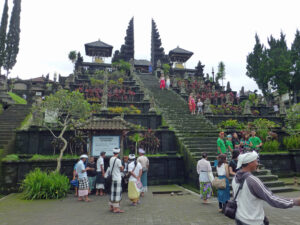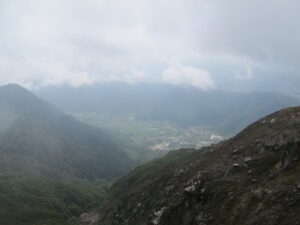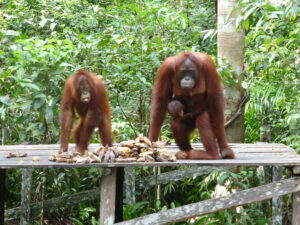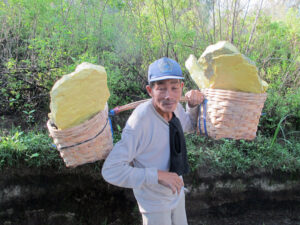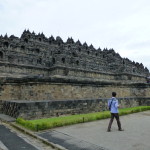
It is almost impossible to see Candi Borobudur (Borobudur Temple) entirely from any vantage point.
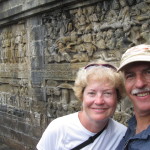
Though only seven levels high, each level is quite wide. On each, a two-meter walkway passes between panel after panel of elaborately detailed stone reliefs added to the face of structural blocks. So the next level up is well recessed from where you are. Plus, the next level is only about two meters higher. That makes the whole temple very squat. From the ground, unless you get quite far away, you can barely detect the 72 stupas arrayed around the large one at the top. From any one level, you can see only one other level above and below. From the top, with no levels visible beneath you, you feel you are floating serenely above the valley below and amid the mountain ridges that surround you.
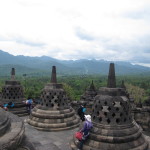
And this limitation of vision seems particularly apt for the structure’s intent, a representation of Mt. Meru, the home of the gods. Like a mandala, the temple symbolizes the process by which the spirit can move up from the base material world of desire on earth through higher levels of idealized form and ultimately to pure formlessness at the crown.
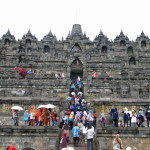
As with the visual experience at Candi Borobudur, it is difficult to see the goal when you’re stuck on the ground in the world of passions and materiality; once transcendent, you should be indifferent to what happens below. Only the four steep staircases at the center of each side give a glimpse of the endpoints, from below neck-wrenchingly steep, from above threateningly precipitous.
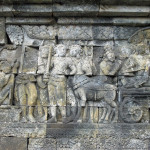
At each level, the stone panels – carved along the inner walls with nearly life-size figures, and along the outer walls with smaller figures interacting dramatically – instruct those who wish to follow the example of Buddha.
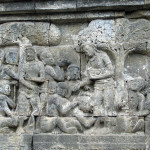
Climbing one level at a time, then circumambulating that level (clockwise) and studying the panels is a long devoted process – what is intended to be a moral progress. To circle every level on your ascent, and view all the panels, you must walk about 5 kilometers. It takes a long time.
But the time for that devotion was 1200 years ago, when Buddhism flourished here in central Java. By then, Hindus and Buddhists from India had moved in, bringing their religious fervor with them. They projected their power and expressed their devotion in grand stone monuments like Borobudur and the nearby Hindu temple complex at Prambanan.
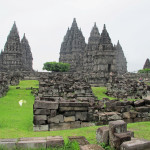
At Prambanan, around the same time, rulers erected a host of towering stone temples, particularly the very big three still standing, devoted to the Hindu trinity of Brahma, Vishnu and – in the center – Shiva. These rival the most ancient temples in India, following principles of design similar to Borobudur.
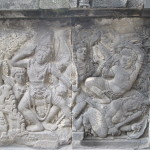
On two of them, you can view the whole illustrated Ramayana epic in wonderfully rendered bas-reliefs. On the third, stories of Lord Krishna.
Eventually, the Hindus moved eastward to Bali, while Muslims and Islam took their place, centered on the capital city of Yogyakarta (pronounced like Joke-jakarta, or in brief Yogya) in the middle of the two holy places. Jungle eventually buried the temples for about a thousand years.
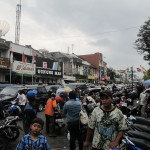
Meanwhile, the charming Yogyakarta remained a sultanate instead until Indonesian independence, when the sultan worked out a deal to keep some privileges including his palace and some powers, while relinquishing others.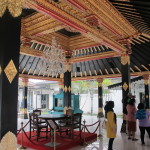
Today, pilgrims to Borobudur come for the on-site museum of exquisite art. Or to check out that World Heritage Site when also touring Yogyakarta and Prambanan. To us, the mix of foreigners and Indonesians seemed there mainly for the tourism, not devotion.
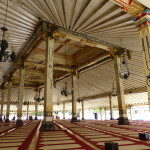
That’s why most visitors head straight to the top for the wonderful view, nirvana on the cheap. They carefully mount the tall steps with perhaps a short pause on any level to catch their breath. So, on a weekend, the staircases are packed; the top is teeming with people. And when they’re finished descending carefully, they’re quickly back in the realm of desire, specifically a horrid walkway lined with hundreds of tacky souvenir hawkers.
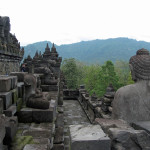
We found the lower levels with the beautiful panels so quiet by comparison, as few care to bother with them except as an occasion for some photo-ops. Nor do many seem to pay much attention to the moral stories or lessons of self-improvement all around them. Perhaps the Buddhists among them take it all more to heart.
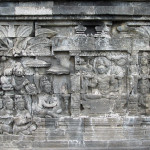
We did see some interest on the lower levels from a number of school groups gaining an open air lesson from their teacher. Otherwise, the weekend throng of uniformed school children seemed much more interested in the foreigners than the friezes. All over Indonesia, teenagers have approached us – and other westerners – asking for an interview. This two or three minute questioning they do seems to be some kind of school exercise or English language practice. The students always read the same questions handwritten on pages ripped from a notebook. “Where are you from? How do you like this place? What do you like about Indonesia?” and so on. One of their group often records the whole thing on a camera.

Here especially, a meeting point for lots of foreigners and lots of school kids high atop the valley, the interviewing was ubiquitous. We did five each; another couple from Australia had already logged three each by the time we talked.
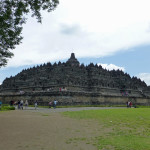
We’re not sure how much enlightenment the questioners received from interviewing us or how much English they learned. They uniformly stuck to the script in their hands. Perhaps they would have been better off asking questions of Buddha. But, shaking hands and trading thank-yous, we all seemed pleased to have escaped the mundane world for a few minutes, up there on the mountain-top.
(Also, for more pictures from Indonesia, CLICK HERE to view the slideshow at the end of the Indonesia itinerary page.)



